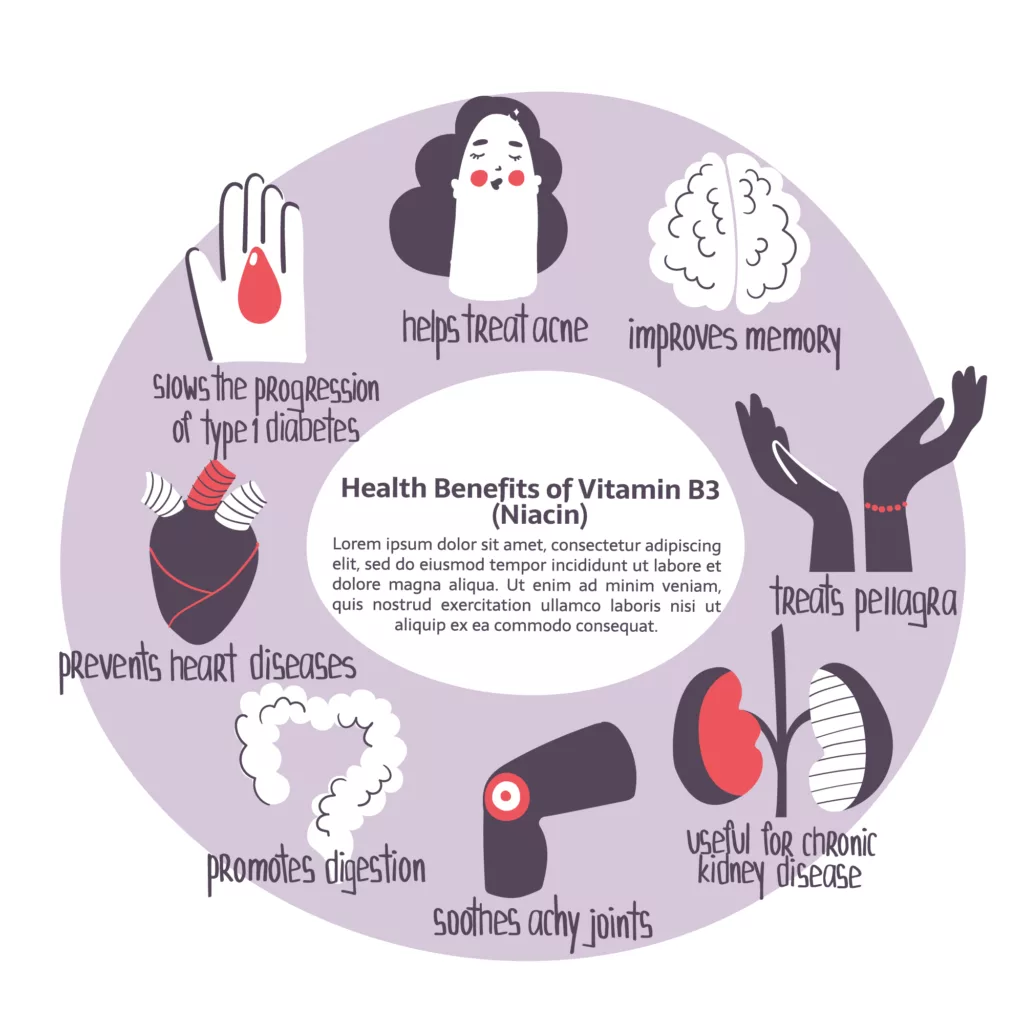Pellagra is a skin condition or disease that a patient acquires when his diet is insufficient in niacin(vitamin B-3) or Tryptophan. The Italian terms pelle (skin) and agra (rough) are where the word “pellagra” originates.
Overview
Diarrhea, dermatitis, and dementia are the “three Ds” used to describe pellagra. The less frequent symptoms of it include Inflammation of the mouth with or without the tongue, disorientation, and delirium. Your physician can diagnose pellagra by conducting a general physical examination, blood test, and observation of these symptoms.
It was one of the most common diseases prevalent in the Southeast United States in older times 1Mills, K., Akintayo, O., Egbosiuba, L., Dadzie, S., Skyles, A., Jang, K., Fatima, S., & Fas, N. (2020). Chronic Diarrhea in a Drinker: A Breakthrough Case of Pellagra in the US South. Journal of investigative medicine high impact case reports, 8, 2324709620941305. https://doi.org/10.1177/2324709620941305The major reason was corn(deficient in niacin) as their staple food. But because of improved farming and dietary practices, it is now extremely uncommon in wealthy nations. It does, however, still exist in several developing nations.
The increase in the levels of niacin and tryptophan to their optimum value will cure the condition in most cases.
Types of Pellagra
Like various other diseases, it also has various types. Pellagra is categorized as primary, secondary, and idiopathic. Now, let’s have a look at its major types.
Primary Pellagra
The most typical form of it is this one. It results from a dietary niacin deficit. The body needs niacin for a number of metabolic functions, including DNA repair and the creation of energy. Numerous symptoms discussed later in the following section can result from a deficiency in niacin in the diet. Primary pellagra is a common occurrence in people whose main source of nutrition is maize or items derived from maize.
Secondary Pellagra
A relatively uncommon type of sickness called secondary pellagra is brought on by illnesses that hinder the body from absorbing and using niacin. Gastrointestinal conditions like Crohn’s disease or celiac disease, as well as the use of drugs that inhibit niacin metabolism, are major causes of it. Contrary to primary pellagra, which is specifically brought on by dietary causes, secondary pellagra necessitates the treatment of the underlying illness. The absorption of these essential nutrients can be enhanced by the consumption of certain medications, initiating certain dietary modifications, and various other measures. But when secondary pellagra is left untreated, it might cause death or a serious neurological disability.
Idiopathic Pellagra
The least common type of pellagra, idiopathic pellagra, has no recognized cause or trigger. Niacin-sufficient individuals, or possibly those without underlying medical disorders that might impair niacin metabolism or absorption, may experience this sort of pellagra. All three kinds have comparable symptoms. However, not much information is available about the idiopathic type, but further research can solve this issue. Further research will make the causes, symptoms & effects of Idiopathic pellagra clear.
Causes of Pellagra
Pellagra is a disease caused by various factors. For instance, a deficiency of niacin or tryptophan. These causes are much more common than the rare ones, like deficiency of lysine. Stated & explained next are its various causes.
Niacin Deficiency

Niacin, or vitamin B3, is a really essential micronutrient. It is essential for the body’s different metabolic functions, including DNA repair and energy synthesis/production. However, the importance of niacin is often underestimated. Consumption of food that does not have a sufficient percentage of niacin can trigger it; for instance, eating corn as a staple food instead of wheat and protein2Redzic, S., Hashmi, M. F., & Gupta, V. (2023). Niacin Deficiency. In StatPearls. StatPearls Publishing.
Tryptophan Deficiency
Tryptophan is one of the precursors of niacin. When tryptophan is not present, the body cannot convert it into niacin, eventually depleting its reserves yet again. Therefore, the advent of pellagra becomes imminent again.
Alcoholism
Alcohol addiction is a very detrimental habit. It breaks down your body slowly and gradually. It has a termite-like effect on the body. Alcoholism results in malnutrition and gastrointestinal disturbances. The gastrointestinal disturbances result in a severe imbalance of B-complex vitamins. That disturbance takes the form of pellagra.
Anorexia Nervosa

Patients with anorexia nervosa have a fear of gaining weight. Due to this fear, these people do not eat adequately. Their habits lead to malnutrition. Their malnourished bodies do not have sufficient backups of vitamin B-3, due to which they usually suffer from it.
Other Causes
Other causes of pellagra include:
- Celiac disease
- Crohn’s disease
- Lysine deficiency
The 3D’s of Pellagra
 The triad—dermatitis, diarrhea, and dementia—is a helpful method to condense the main consequences of the condition.
The triad—dermatitis, diarrhea, and dementia—is a helpful method to condense the main consequences of the condition.
A skin rash known as dermatitis typically develops on exposed body parts like the neck, arms, and legs. It is possible for the rash to be red, scaly, or rough in texture.
Another typical pellagra symptom is diarrhea. Chronic cases might result in starvation, dehydration, and weight loss.
In severe forms of the disease, patients also face dementia. Memory loss, confusion, and cognitive decline characterize dementia.
However, it is not always the case for the patients to have only the three common symptoms; they may also experience other symptoms, such as:
- Fatigue
- Headache
- Mouth ulcers
- Sore throat
- Anemia
- Photosensitivity
- Confusion
How is Pellagra Diagnosed?
It is characterized by a combination of three main symptoms, commonly known as the 3Ds: dermatitis, diarrhea, and dementia.
If a physician suspects that a patient has pellagra, they may order a urine test. This test is helpful in diagnosing pellagra because it can indicate a chemical imbalance in the body. Specifically, pellagra patients often have low levels of the amino acid tryptophan in their urine. Additionally, other blood tests may be performed to assess various factors such as protein levels to check for hypoproteinemia, blood count, serum calcium, and phosphorus.
High serum calcium and low phosphorus levels are common among pellagra patients. The high calcium level is due to the fact that niacin deficiency can cause the body to absorb calcium from bones, leading to elevated serum levels. The low phosphorus level is due to the fact that phosphorus is necessary for the body to metabolize niacin, and a deficiency in niacin can lead to lower levels of phosphorus in the blood.
Lastly, evaluating serum porphyrin levels is also a crucial diagnostic tool for pellagra. Blood testing can detect a disruption in the production of porphyrins in pellagra, where these organic compounds play a crucial role in heme production, a vital component of hemoglobin in red blood cells.
What is Pellagra Rash?

Pellagra often manifests with skin rashes, including the characteristic Pellagra rash. There may be discomfort, burning, or itching along with the rash. It can disturb the body’s normal metabolism. Not everyone who has it will get a rash. Each person has a different level of rash severity and distribution.
Treatment
The main course of action and objective is to treat the underlying niacin deficit. Dietary adjustments and taking nutritional supplements of Vitamin B3 is a convenient and suitable way out of it 3Hołubiec, P., Leończyk, M., Staszewski, F., Łazarczyk, A., Jaworek, A. K., & Rojas-Pelc, A. (2021). Pathophysiology and clinical management of pellagra – a review. Folia medica Cracoviensia, 61(3), 125–137. https://doi.org/10.24425/fmc.2021.138956 Niacin supplements are also sold over the counter under various trade names. Doctors prescribe these as per necessity.
Foods like meat, fish, poultry, beans, and fortified cereals are rich in Vitamin B-3. This is specifically necessary for patients who suffer from it due to tryptophan deficiency, anorexia nervosa or are otherwise malnourished.
In addition to this, the rehabilitation of alcoholics is of primary importance. They can reduce the gastrointestinal deficit they experience on a day-to-day basis by gradually tapering off their daily dose of alcohol. Once they completely cut out alcohol from their diet, the liver recovers, and the body recoils back to its standard form. However, this entire process requires proper guidance & external aid in the form of counseling and medications.
Treatment might be necessary for one or more of the signs & symptoms of pellagra, such as cognitive impairment, diarrhea, or skin rash. Medical recommendations include prescribing corticosteroids for rash, administering anti-diarrhea drugs for diarrhea, and implementing cognitive therapy for dementia.
Patients with extreme stages of pellagra may require hospitalization to address their dehydration, malnutrition, and other pellagra-related problems.
Prevention
Prevention is better than cure. Adding specific portions of B3-containing foods to the diet is important. To stop the onset of pellagra(specifically for alcoholics) caused by a B3 deficiency, continuous monitoring and taking supplements regularly.
To Sum It Up
Prevention is the best method for treating this disease. We often observe symptoms like weariness, cognitive decline, diarrhea, and skin rashes. Even though pellagra is uncommon in developed nations, it is still a significant health concern in some poor nations. It becomes imperative to address the underlying niacin shortage by consultation with the doctor and making the necessary changes to one’s way of life. To avoid long-term consequences, it’s critical to recognize the pellagra symptoms and seek medical assistance as soon as you can.
Refrences
- 1Mills, K., Akintayo, O., Egbosiuba, L., Dadzie, S., Skyles, A., Jang, K., Fatima, S., & Fas, N. (2020). Chronic Diarrhea in a Drinker: A Breakthrough Case of Pellagra in the US South. Journal of investigative medicine high impact case reports, 8, 2324709620941305. https://doi.org/10.1177/2324709620941305
- 2Redzic, S., Hashmi, M. F., & Gupta, V. (2023). Niacin Deficiency. In StatPearls. StatPearls Publishing.
- 3Hołubiec, P., Leończyk, M., Staszewski, F., Łazarczyk, A., Jaworek, A. K., & Rojas-Pelc, A. (2021). Pathophysiology and clinical management of pellagra – a review. Folia medica Cracoviensia, 61(3), 125–137. https://doi.org/10.24425/fmc.2021.138956

